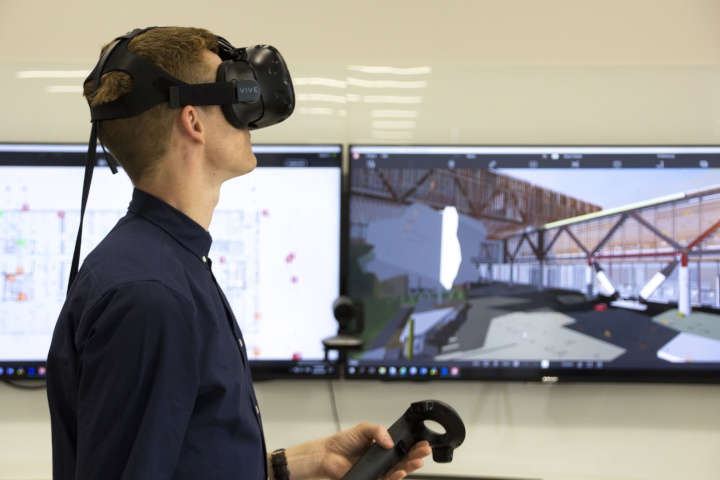Ngāi Tahu Property And ACC Using Technology To Improve Worker Safety
An upcoming state-of-the-art office building in Dunedin will be the case study for new safety trials, aimed at lowering the high number of workplace accidents in the building industry.

Architect using BIM technology. Credit: Warren and Mahoney.
Ngāi Tahu Property and ACC have joined forces with the Construction Industry to reduce the high rates of accidents and injuries on construction sites, through Building Information Modelling (BIM).
Currently, the construction industry represents 8% of the workforce, but accounts for more than 16% of ACC work claims, at a cost of $158 million annually.
The new partnership will take the form of a project called BIMSafe NZ, a $1.7 million three-year collaboration between the Canterbury Safety Charter and the Building Innovation Partnership (BIP) at the University of Canterbury. The project is funded by ACC’s Workplace Injury Prevention Grants and MBIE.
The project aims to reduce workplace harm by developing best practice guidelines for integrating health and safety information into BIM models and then enabling workers to access the models in real-time.
The future ACC office building in Dunedin, being managed by Ngāi Tahu Property and designed by Warren and Mahoney, will be used as a case study to trial the guidelines, and provide feedback on their effectiveness.
The building is a 50:50 joint venture between Ngāi Tahu Property and the ACC investment team and will feature 8000 square metres of office space. Construction is due to commence in March 2022 and is expected to be completed in early 2024.
Ngāi Tahu Property Development Manager, James Jackson says the construction project is the perfect opportunity for the safety trials.
“As a values-led organisation and leading developer, Ngāi Tahu Property want to do everything we can to help the industry provide safer workplaces. BIMSafe NZ is set to be a game-changer for the industry, and we are looking forward to playing a part in achieving this.”
The use of BIM in New Zealand construction projects has doubled in the last five years and is now a requirement on all Government facilities projects valued at greater than $5 million.
Brad Sara, BIMSafe Advisory Group member and Head of Technology at Warren and Mahoney says; “The BIMSafe NZ project will be a step-change for how health and safety is procured and delivered in New Zealand. This will extend the capability of the health and safety design process into the realm of computer gaming.”
As the use of Health and Safety Integrated BIM gains momentum with subcontractors and workers, the industry is expected to experience a positive cycle of uptake, impact, and most importantly, change.
Virginia Burton-Konia, Manager, Workplace Safety, ACC says; “People are the most important thing in any company and taking care of them should be every employer’s top priority. ACC is committed to partnering with Industry to support initiatives that enable sector/industry groups to strive for an improvement in workplace health, safety, and wellbeing. We know that where businesses are able to keep their workforces safe and well and free from injury, they are more likely to see increased worker engagement at every step of their improvement journey. Ultimately this also results in higher business productivity.”
The knowledge garnered from this Project through the guidelines, case study and technology will have far-reaching benefits. Sharing this knowledge through education and engagement of the wider industry provides the opportunity to transform the construction sector and literally save lives.
Background on BIM
technology
BIM is a three-dimensional computer
model of a construction project, in a similar way that
Google Maps is a digital representation of roads and
places.
The BIM model can be utilised for all components of the design process and enables architects, engineers, contractors, and workers to assess and mitigate safety risks in the computer model before, during and after the construction process. It can be used to design, plan, and simulate an entire construction process right through to maintenance and decommissioning.


 ASB Bank: ASB Business Survey - The Impact Of Trump's Tariffs, According To Kiwi Businesses
ASB Bank: ASB Business Survey - The Impact Of Trump's Tariffs, According To Kiwi Businesses University of Auckland: Will Robots Help Older People Stay Sharp?
University of Auckland: Will Robots Help Older People Stay Sharp? Electricity Authority: Authority Confirms New Next-Gen Switching Service; Proposes Multiple Trading Relationships For Consumers
Electricity Authority: Authority Confirms New Next-Gen Switching Service; Proposes Multiple Trading Relationships For Consumers Mānuka Charitable Trust: Mānuka Charitable Trust Warns Global Buyers Of Misleading Australian Honey Claims
Mānuka Charitable Trust: Mānuka Charitable Trust Warns Global Buyers Of Misleading Australian Honey Claims  Engineering New Zealand: NZ Building System Needs Urgent Improvement
Engineering New Zealand: NZ Building System Needs Urgent Improvement GNS Science: Bioshields Could Help Slow Tsunami Flow
GNS Science: Bioshields Could Help Slow Tsunami Flow


